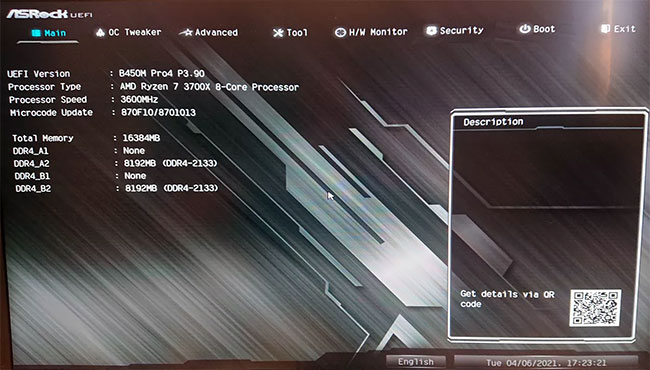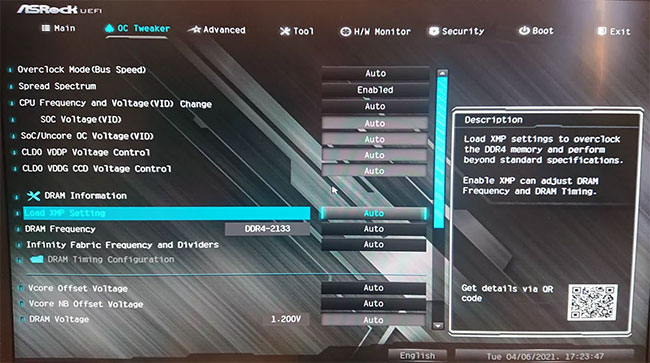Enable XMP to optimize RAM speed
You may not know, but in reality, RAM will always run at a slower speed than it is designed for, unless you manually adjust its speed or enable Intel XMP to optimize RAM speed. .
Note, this option will not be available on every motherboard BIOS and not every RAM stick will have an XMP profile. Some RAM models are only designed to run at standard speeds. However, let's say you're building your own gaming rig and buying a RAM system that's advertised to be incredibly fast, you should definitely choose to buy devices that support the XMP option.
Why do we need XMP?
Before enabling XMP, it's important to understand how your CPU connects to RAM and why XMP is necessary in the first place.
You see, the CPU on your system is connected to the RAM through the motherboard using sockets. It is through these sockets that data reaches the CPU. Therefore, the motherboard, CPU, and RAM must work together to get data from RAM to the CPU.
For everything to work correctly, the motherboard on your computer uses a small chip that stores the BIOS (Basic Input/Output System). This chip works when you turn on the computer. Once powered, the BIOS will perform a power self-test (POST). During this test, the motherboard checks the status and initialization of various input/output devices connected to the CPU. During this test, the motherboard decides the frequency at which the RAM will run.

To do this, the motherboard communicates with Serial Presence Detect (SPD), a chip that stores information such as RAM frequency, voltage, and time. The data stored on this SPD is standardized for different RAM technologies such as DDR2, DDR3 and DDR4 by JEDEC (Joint-Electron-Device-Engineering-Council).
Because of this standardization, DDR4 RAM can run at frequencies between 800 and 1600 MHz with data rates of up to 3200 megatransfer/second (MT/s). However, a high-performance RAM stick can reach up to 5333 MT/s.
This raises the question of how does RAM surpass the JEDEC specification and run at faster frequencies? This is where XMP appears to play its role.
What is the purpose of activating XMP?
RAM runs at standard speeds specified by JEDEC, but you can manually overclock your RAM. XMP uses some RAM memory to store speed profiles and times that RAM can safely run. Enabling XMP configures memory to run at the speed and timing for which it is rated.
How to enable XMP on memory
Some motherboards do not allow the use of XMP and will not have the option to enable it or will be grayed out when you try to use the feature. In that case, there's nothing you can do, other than upgrade your motherboard to use XMP.
1. Restart your PC or turn it on and access UEFI/BIOS using the specific key on your motherboard. Typical access keys include Delete, F1, F2, F10 , and F12 (yours may be different). Check your motherboard manual or the manufacturer's website for details.

2. Search for the XMP profile toggle button. If you see it on your UEFI/BIOS home screen, switch it to On , then go to step 6. If not, go to step 3.
3. If necessary, enable Advanced Mode on your UEFI/BIOS. Usually press the F7 key , but again, this button will depend on your motherboard. Usually, that information is in the bottom right corner.
4. Navigate to the overclocking section in BIOS. This section may be called AI Tuner, AITweaker, Performance, Extreme Tweaker, Overclock Settings or something similar.
5. Scroll through the list of options until you find the XMP profile toggle button. Switch it to On by pressing the Enter key on it or clicking on it and selecting On from the drop-down menu. Some motherboards, as shown below, require you to Load XMP Profile .

6. Save BIOS settings and exit. You can do this by selecting the Exit button with your keyboard or mouse and choosing to save your settings. Alternatively, use the traditional F10 key. When prompted, confirm your choice.
How do I know if XMP is enabled?
You can check if your XMP profile is enabled by going back to UEFI/BIOS and making sure the toggle is On . Also check the memory speed in the UEFI/BIOS - it may be on the main screen or overclocking menu - or in the post screen when the PC starts up.
You can also use Windows software like CPUZ to confirm your memory speed. If it matches the rated speed given on the memory's packaging and label, your XMP profile is enabled.
If not, run the steps again to make sure you enabled it correctly. If you're sure you've followed the steps correctly and you're still not seeing the expected speeds, you should confirm that your motherboard or processor allows memory overclocking.
 8 ways to open Advanced Startup Options on Windows 10
8 ways to open Advanced Startup Options on Windows 10 Why is Microsoft Surface Pro 11 better than iPad Pro M4?
Why is Microsoft Surface Pro 11 better than iPad Pro M4? AMD just released a free tool that all PC gamers should try
AMD just released a free tool that all PC gamers should try 8 rules to break when taking photos on your phone
8 rules to break when taking photos on your phone Why not choose Adobe Creative Cloud in 2024?
Why not choose Adobe Creative Cloud in 2024? Mistral announces Large 2: flagship LLM with 123 billion parameters
Mistral announces Large 2: flagship LLM with 123 billion parameters